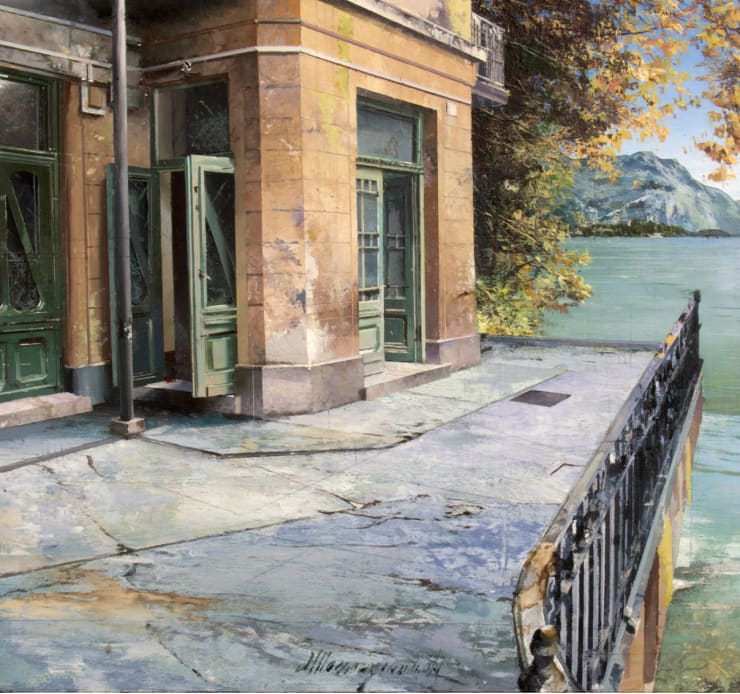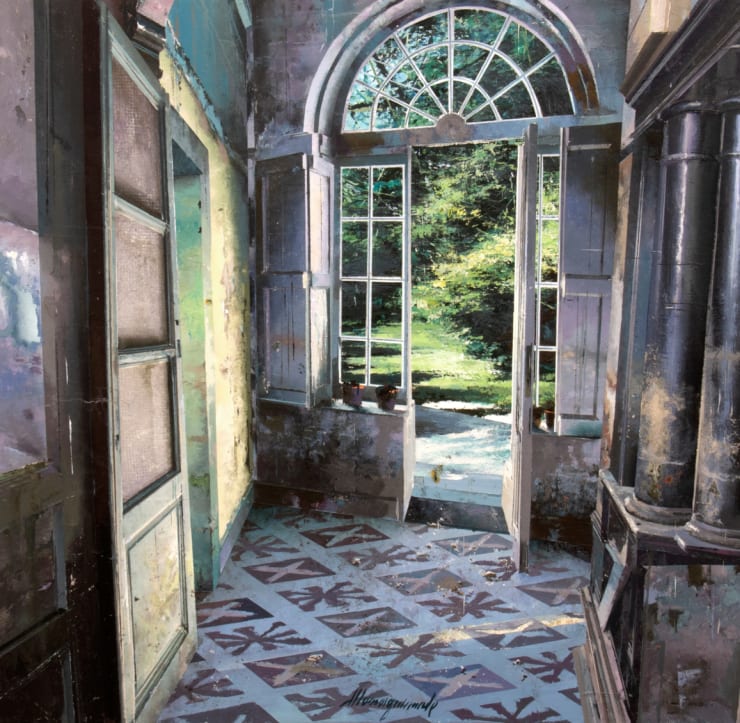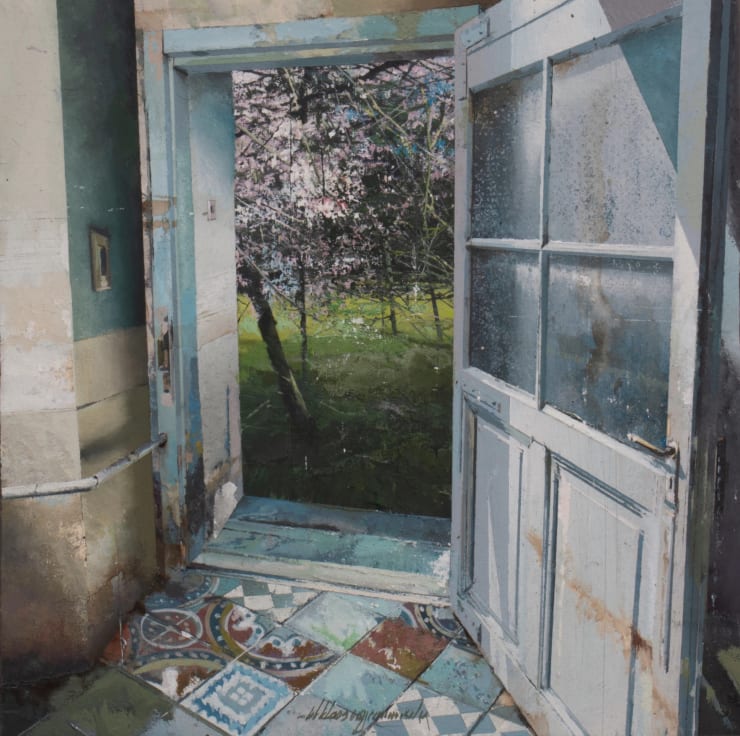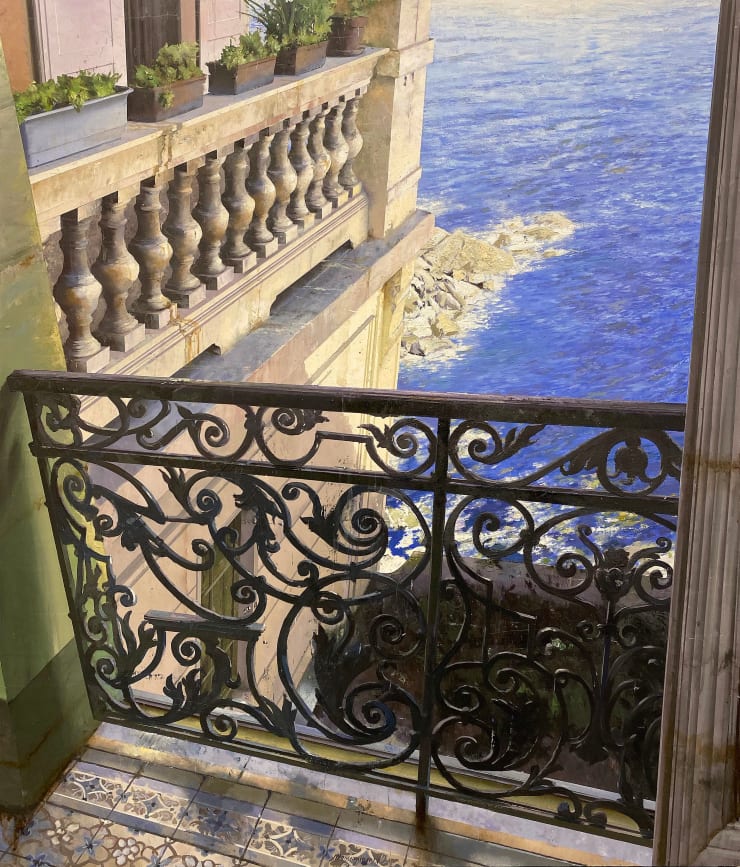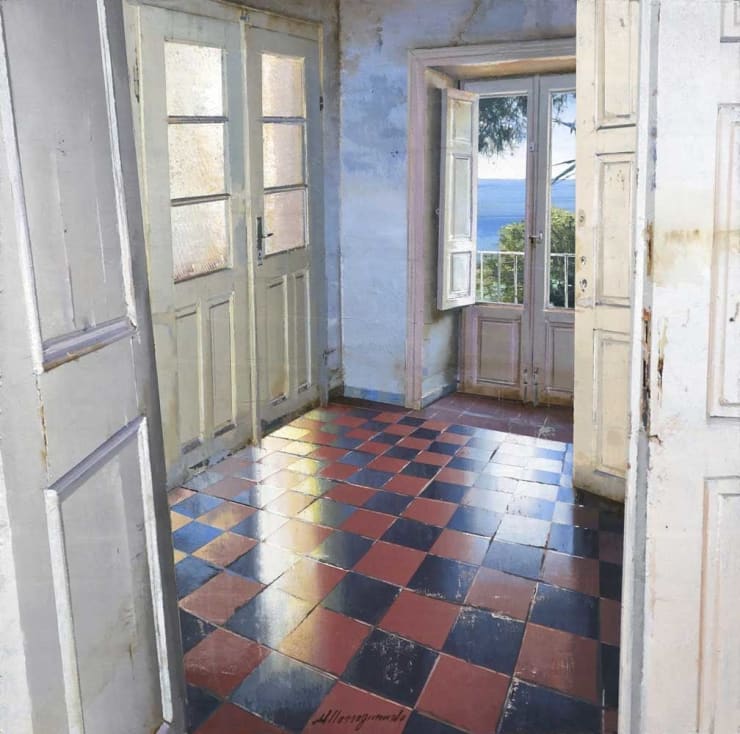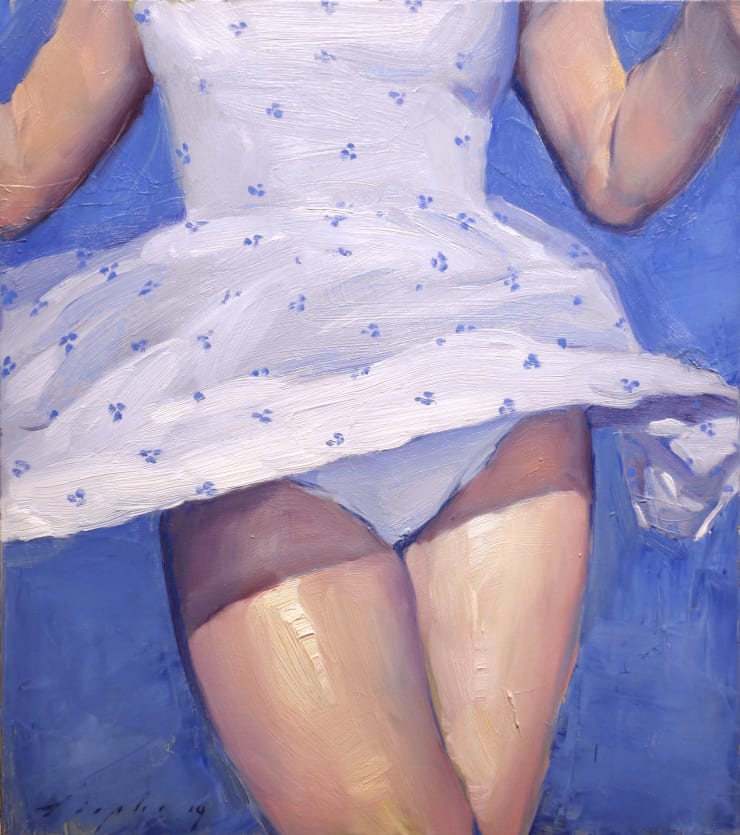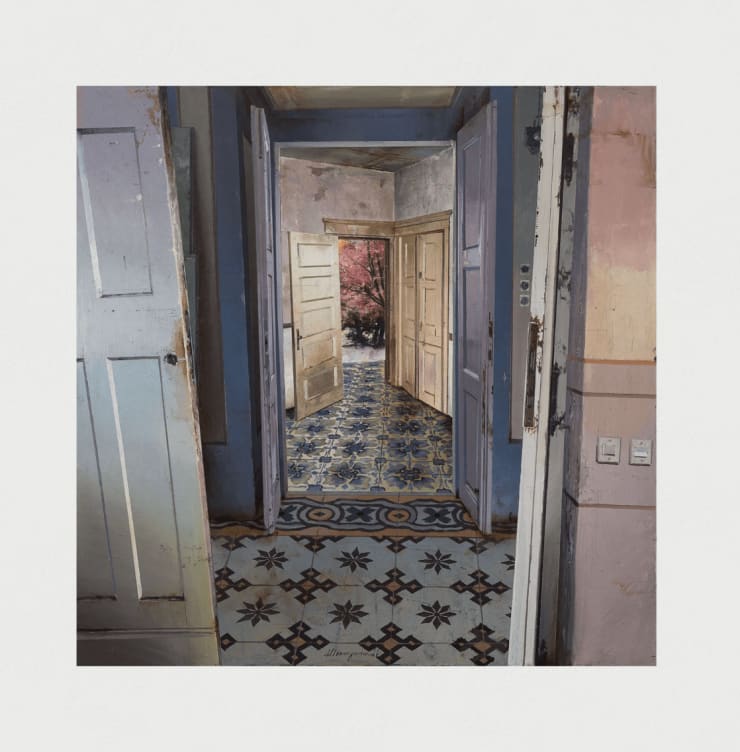Matteo Massagrande Italy, b. 1959
Born in 1959 in Padua, Italy, Matteo Massagrande is a painter steeped in the history and tradition of figurative representation. He has been exhibiting his work since 1973, and has shown extensively around the world, his paintings featuring in many public and private collections. He divides his time between Padua and Hajos, Hungary. The influences of both locations are fundamental to the content and spirit of his practice. This is his source material.
The nature of his subject is intriguing and mysterious. He shows unoccupied, decayed, possibly abandoned, domestic interiors. These still and eloquent rooms are freighted with absence and melancholy. This is offset by the sophisticated handling of light and colour, which seduces the eye and lends a lighter atmosphere of interested enquiry. These rooms have intricate tiled floors, which flow from one space to the next, leading the eye to subsequent rooms and eventually to garden-like exteriors. What one begins to notice are deliberate variations in perspective, emphasised by the grids of tiling, which suggest that these paintings do not simply record a view, but are elaborate constructs. They are in fact composite images, collated to produce theatrical and compressed evocations of location and history.
A tension plays out in these outwardly calm and controlled images. The subject, a point in time and space, is elusive, constantly changing and sitting on the edge of perception. Massagrande's careful rendering of his systematic and forensic observations makes paintings of rich visual density, which effectively capture and pin down a significant moment within his rigorous method.
-
 Matteo MassagrandeIndaco, 2023Oil on board50 x 50 cm
Matteo MassagrandeIndaco, 2023Oil on board50 x 50 cm
19.7 x 19.7 in -
 Matteo MassagrandeOttobre al lago, 2023Oil on board30 x 30 cm
Matteo MassagrandeOttobre al lago, 2023Oil on board30 x 30 cm
11.8 x 11.8 in -
 Matteo MassagrandeSerra, 2023Mixed media on board15 3/4 x 15 3/4 in
Matteo MassagrandeSerra, 2023Mixed media on board15 3/4 x 15 3/4 in
40 x 40 cm -
 Matteo MassagrandeVetrata sul giardino, 2023Oil on board30 x 30 cm
Matteo MassagrandeVetrata sul giardino, 2023Oil on board30 x 30 cm
11.8 x 11.8 in -
 Matteo MassagrandeAncora Primavera, 2022Oil on board12 x 12 in
Matteo MassagrandeAncora Primavera, 2022Oil on board12 x 12 in
30 x 30 cm -
 Matteo MassagrandeCipresso, 2022Oil and mixed media on board19 ½ x 23 ½ in
Matteo MassagrandeCipresso, 2022Oil and mixed media on board19 ½ x 23 ½ in
50 x 60 cm -
 Matteo MassagrandeLuci della Grecia II, 2022Oil and mixed media on board50x60cm
Matteo MassagrandeLuci della Grecia II, 2022Oil and mixed media on board50x60cm -
 Matteo MassagrandeLuci della Grecia VIII, 2022Oil on board23 5/8 x 31 1/2 in
Matteo MassagrandeLuci della Grecia VIII, 2022Oil on board23 5/8 x 31 1/2 in
60 x 80 cm -
 Matteo MassagrandeCasa di Nelly, 2021Oil and mixed media on board20 x 20 in
Matteo MassagrandeCasa di Nelly, 2021Oil and mixed media on board20 x 20 in
50 x 50 cm -
 Matteo MassagrandeIl cortile del manicomio, 2021Oil and mixed media on board59 x 59 in
Matteo MassagrandeIl cortile del manicomio, 2021Oil and mixed media on board59 x 59 in
150 x 150 cm -
 Matteo MassagrandeNevicata, 2021Oil and mixed media on board14 x 23 ½ in
Matteo MassagrandeNevicata, 2021Oil and mixed media on board14 x 23 ½ in
35 x 60 cm -
 Matteo MassagrandeAmsterdam, 2020Oil on canvas on board59 x 59 in
Matteo MassagrandeAmsterdam, 2020Oil on canvas on board59 x 59 in
150 x 150 cm -
 Matteo MassagrandeBowling Green, 2020Oil and mixed media on board59 x 39 ½ in
Matteo MassagrandeBowling Green, 2020Oil and mixed media on board59 x 39 ½ in
150 x 100 cm -
 Matteo MassagrandeIl grande platano, 2020Oil and mixed media on board19 x 30 in
Matteo MassagrandeIl grande platano, 2020Oil and mixed media on board19 x 30 in
49 x 77 cm -
 Matteo MassagrandeLa luna di febbraio, 2020Oil and mixed media on board17 x 12 in
Matteo MassagrandeLa luna di febbraio, 2020Oil and mixed media on board17 x 12 in
44 x 30 cm -
 Matteo MassagrandeLa risacca, 2020Oil and mixed media on board45 x 39 ½ in
Matteo MassagrandeLa risacca, 2020Oil and mixed media on board45 x 39 ½ in
115 x 100 cm
-
 Matteo MassagrandeSambuco, 2020Oil and mixed media on board27 ½ x 31 ½ in
Matteo MassagrandeSambuco, 2020Oil and mixed media on board27 ½ x 31 ½ in
70 x 80 cm -
 Matteo MassagrandeLa porta sul giardino, 2018Oil and mixed media on board23 ½ x 23 ½ in
Matteo MassagrandeLa porta sul giardino, 2018Oil and mixed media on board23 ½ x 23 ½ in
60 x 60 cm -
 Matteo MassagrandeLa barchessa, 2017Oil on board16 x 16 in
Matteo MassagrandeLa barchessa, 2017Oil on board16 x 16 in
40.6 x 40.6 cm -
 Matteo MassagrandeNuovo mattino al mare, 2017Oil on board19 3/4 x 19 3/4 in
Matteo MassagrandeNuovo mattino al mare, 2017Oil on board19 3/4 x 19 3/4 in
50 x 50 cm -
 Matteo MassagrandeIl balcone del faro, 2016Oil on board16 x 16 in
Matteo MassagrandeIl balcone del faro, 2016Oil on board16 x 16 in
40.6 x 40.6 cm -
 Matteo MassagrandeVia Marconi 22, 2016Oil on board16 x 16 in
Matteo MassagrandeVia Marconi 22, 2016Oil on board16 x 16 in
40.6 x 40.6 cm -
 Matteo MassagrandeVeranda, 2015Oil on board9 x 14 in
Matteo MassagrandeVeranda, 2015Oil on board9 x 14 in
22.9 x 35.6 cm
-

Tribeca Pool Party
9 Jul - 24 Aug 2024Read more -

Tribeca Summer Show
27 Jul - 19 Aug 2023Against the backdrop of sun-kissed skyscrapers and bustling streets, Friedrichs Pontone is thrilled to present our Tribeca Summer show, an extraordinary group exhibition that encapsulates the eclectic spirit of this...Read more -

Matteo Massagrande
Infinite Places 11 Nov - 23 Dec 2022Friedrichs Pontone is delighted to present its first show of paintings by distinguished painter Matteo Massagrande. Italian master, Matteo Massagrande, has had a long and distinguished career. He has been...Read more -

LAUNCH
9 Sep - 2 Oct 2022A new contemporary art gallery, Friedrichs Pontone, opens in Tribeca. A joint venture between Martin Friedrichs from New York and Domenic Pontone from London that combines a wealth of art...Read more -

Soft Launch
22 Jun - 27 Jul 2022Welcome to our new contemporary gallery in the heart of TribecaRead more
-

Aspen Art Fair
29 Jul - 2 Aug 2025Friedrichs Pontone is delighted to exhibit at the second edition of The Aspen Art Fair. Presenting works by seven artists, our exhibition is a rich...Read more -
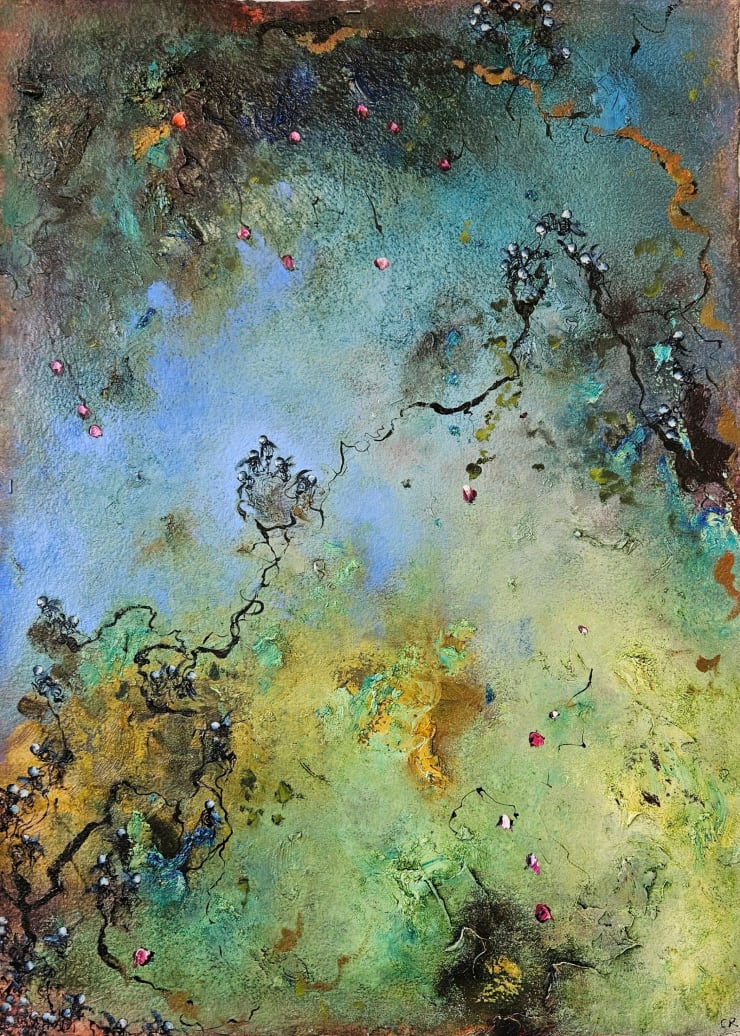
Seattle Art Fair
17 - 20 Jul 2025Friedrichs Pontone is pleased to be presenting at the 2025 edition of Seattle Art Fair. Included in the exhibition are works by Angela Glajcar, Chris...Read more -

Art on Paper 2023
7 - 10 Sep 2023Read more -

Intersect Aspen 2023
1 - 4 Aug 2023Friedrichs Pontone is thrilled to be participating in the 2023 edition of Intersect Aspen taking place in Aspen, Colorado from 1 August through 4 August....Read more -

Intersect Palm Springs
9 - 12 Feb 2023Friedrichs Pontone is delighted to participate in the 2023 edition of Intersect Palm Springs, showcasing a selection of works by leading artists from across the...Read more -

Intersect Aspen
31 Jul - 4 Aug 2022Friedrichs Pontone is delighted to participate in the 2022 edition of Intersect Aspen, showcasing a selection of works by leading artists from across the gallery’s...Read more


